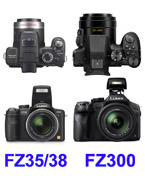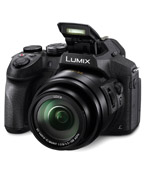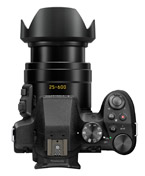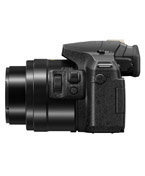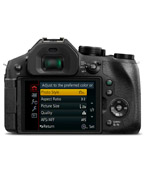Sharpness
We deal here with the distinguishable detail, although other advanced measurements are also important, such as contrast in details. Let me first explain some basics.
Sharpness in 35mm film photography
In 35mm film camera photography, sharpness is measured by the number of distinguishable “lines per millimetre”, where “lines” means black lines over a white background. Inevitably, between black lines there are “separator” white lines, and therefore it is more proper to talk of “line pairs per millimetre”, abbreviated lp/mm. In professional 35mm cameras the sharpness limit was imposed by both the optics and the film grain (which varied between 30 and 100 lp/mm). It was considered an excellent “amateur” result to achieve 30 lp/mm in a picture, while a “professional” value would be around 60 lp/mm. In the 1960's I tested my Voigtländer Ultramatic camera with the Color Skopar 50mm 1:2.8 and Agfacolor slide film, and got something like 30 lp/mm, with the pictures looking very sharp.
Sharpness in digital photography
Once we scan the film with a high quality scanner, since in digital photography we will deal with pixels, instead of “line pairs per millimetre” we count simple lines, and our new unit is “line widths per picture height”, abbbreviated lw/ph. To convert between these two units we need to convert millimetres to picture height, which in 35mm film is 24mm. So if we call L the sharpness of a picture in lp/mm (30 and 60 in our examples above) and we wish to calculate the sharpness in lw/ph, which we call W, the formula is W = 24 (height in mm) x 2 (lines in a pair) x L, which simplifies as W = 48 x L. In our examples, the equivalent of “amateur” L=30 is W=48x30=1440 lw/ph, and for “professional” L=60 we have W=48x60=2880 lw/ph.
The 4000x3000 pixels (12Mpx) sensor resolution of many present-day digital cameras (the FZ300 included) implies 3000 vertical pixels (vp). This will hardly be enough to achieve the above “professional” value of 2880 lw/ph. Furthermore, the camera's quality (sensor, lens and digital process) significantly lowers the sharpness, and reviewers normally consider 2000 lw/ph a very good value (equivalent to 42 lp/mm for 35mm film).
Not many reviews of the FZ300 include the labour-intensive sharpness test. One that does is by PCMag. The website shows only three measurements, all for aperture 2.8 (and supposedly ISO 100):
25mm: 1,875 lw/ph “center-weighted test, in excess of the 1,800 we look for”.
100mm: 1,920 lw/ph in center and mid, but edges drop to 1,600, “still a solid result”.
Measuring FZ300's sharpness: monitor tests
Sharpness is measured by taking pictures of a test pattern. I first used my own test chart of 1600x1200 pixels on my monitor screen, which has 1200 vertical pixels. The test chart can measure accurately only up to about 1000 lw/ph. I took pictures of the screen for every aperture 2.8, 4.0, 5.6 and every zoom “stop”. Although some corners were a bit soft, all the values were above 1000 lw/ph as expected. However, we could see differences between the different apertures:
- The sharpest pictures are with aperture 4.0
- Less sharp are pictures with apertures 2.8 and 5.6
- Significant softness is observed with aperture 8.0, clearly to be avoided
At this stage we can say that the FZ300 sharpness is remarkable. If your pictures will eventually be all watched in a 1600x1200 monitor, with any aperture and any zoom length the sharpness will always be at least as high as the monitor can deliver.
Measuring FZ300's sharpness: printed chart tests
But of course a higher resolution is needed for (a) high definition monitors, (b) extracting from a picture a detail as a new picture and (c) printing. We know that the FZ300 can achieve anything above the already-tested 1000 lw/ph and below 2500 lw/ph, which is about the maximum value that can be measured when the absolute maximum is the 3000 vertical pixels.
For these tests we produced a special test chart, we printed it in 4 pages glued together and took pictures with the 4 aperture "stops" and 13 zoom lengths (a total of 4x13=52 pictures). On each picture we measured sharpness in the centre, borders, best corner and worst corner: a total of 4 values. We entered the 4x52=208 values in a spreadsheet. Let us first see some general conclusions.
Sharpness at different aperture stops
These are the minimum, average and maximum sharpness in lw/ph for every aperture, suitably rounded (mind that every measurement has a accuracy not better than about +/-50):
Ap. Min. Ave. Max. Conclusions
2.8 1500 1810 2200 The “Min.” is the typical “worst corner” measurement.
4.0 1400 1860 2200 The average is better than for 2.8, but not very significantly!
5.6 1400 1830 2100 Looks very similar to the values for 2.8!
8.0 1300 1570 1700 All the values are decidedly lower than for other apertures.
Our sharpness curves for the FZ300
For more detailed analysis we need the full data: find below the charts with all the measurements. Mind that for better accuracy the Y-axis starts at 1000: this makes differences look almost twice as large as they actually are. For example, in the chart for Aperture 2.8, the sharpness in the Worst corner (in red) looks like half the sharpness in the Centre (in green), but if you look at the values you see that the Worst corner has actually about 3/4 the sharpness of the Centre (let us check with our numerical data: the averages of the two curves are 2119 and 1512, so the latter is 71% of the former).
We can now state some more detailed conclusions..
Sharpness in different parts of the picture
For the conclusions below we have compared not only averages but also the above curves:
- Centre: ave. 1960 lw/ph, with 2.8 always outperforming 5.6
(this happens because of the diffraction caused by closing the aperture blades in 5.6) - Borders ave.: ave. 1810 lw/ph, and always quite near to the Centre values
- Worst corner: ave. 1540, with 5.6 outperforming 2.8
(this is because closing the aperture reduces the effect of lens imperfections)
From the last curve above it is also apparent that 8.0 produces a very even sharpness throughout the picture: unfortunately this is achieved not by sharpening the corners, but instead by blurring the centre! From this and the previous paragraph we extract the conclusions below.
Recommendation about Aperture stops and Sharpness
2.8: If possible use it only when you really need the maximum luminosity.
4.0: Best overall sharpness, slightly better than 2.8.
5.6: Best to prevent soft corners.
8.0: Use this only in close-ups to improve the depth of field.
You get an ave 250 more lw/ph with wider aperture stops.
Recommendation about Zoom lengths and Sharpness
By perusing our numerical data tables it is also apparent that the sharpness is quite even throughout the zoom's entire range, with just the following exceptions due to—this and also any—long zoom imperfections. Interestingly, closing the aperture by two EV stops mitigates some imperfections, but produces new ones at the extreme telephoto. The conclusions:
2.8 and 4.0: For best results, avoid zoom lengths 250 and 500mm,
where sharpness falls by 200 lw/ph ( 200, 300, 400 and 600mm are OK).
5.6 and 8.0: For best results in corners, avoid zoom lengths 500mm and higher.
